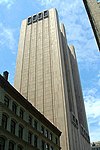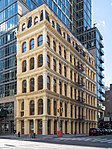319 Broadway
1870 establishments in New York (state)Broadway (Manhattan)Cast-iron architecture in New York CityItalianate architecture in New York CityNew York City Designated Landmarks in Manhattan ... and 3 more
Office buildings in ManhattanTribecaUse mdy dates from August 2020

319 Broadway, also known as the Metropolitan Life Insurance Company Home Office, is a five-story office building on the corner of Broadway and Thomas Street in the Tribeca neighborhood of Manhattan, New York City. It is a cast-iron building in the Italianate architecture style, built in 1869–70 and designed by D. & J. Jardine. It is the lone survivor of a pair of buildings at 317 and 319 which were known as the "Thomas Twins". The cast iron for these mirror-twin buildings was provided by Daniel D. Badger's Architectural Iron Works. The building was designated a New York City landmark on August 29, 1989.
Excerpt from the Wikipedia article 319 Broadway (License: CC BY-SA 3.0, Authors, Images).319 Broadway
Broadway, New York Manhattan
Geographical coordinates (GPS) Address Nearby Places Show on map
Geographical coordinates (GPS)
| Latitude | Longitude |
|---|---|
| N 40.71596 ° | E -74.00521 ° |
Address
Broadway 321
10007 New York, Manhattan
New York, United States
Open on Google Maps








